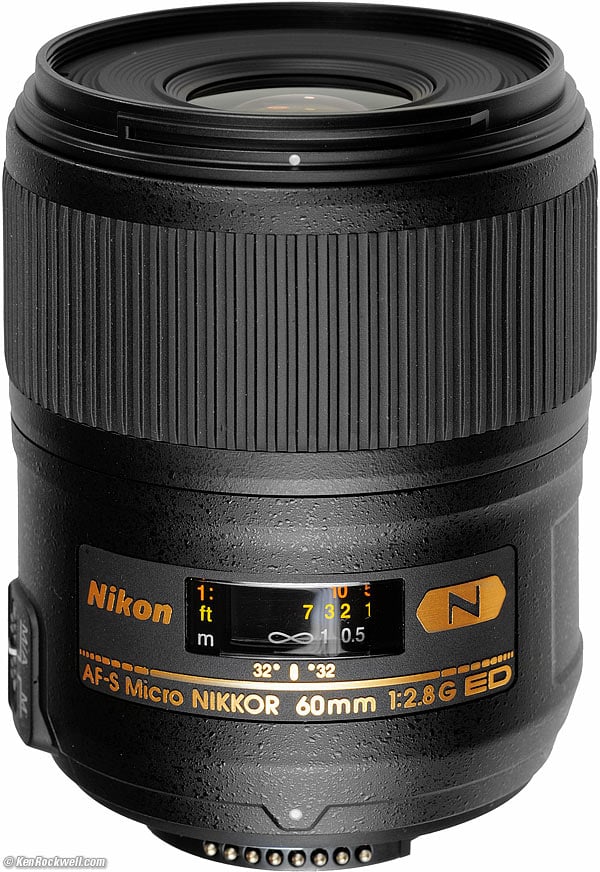Home Donate New Search Gallery Reviews How-To Books Links Workshops About Contact
Nikon
60mm AF-S G
Micro-NIKKOR G (2008 - )
© 2011-2013
KenRockwell.com. All rights reserved.
How to Shoot Macro Best Macro Lenses Compared
Intro Specifications Performance Recommendations
Nikon 60mm f/2.8 AF-S Micro-Nikkor (FX, DX and 35mm coverage, 62mm filters, 15.1 oz./428g, 0.6'/0.185m 1:1 close focus, about $550). enlarge. I got this one one from Adorama; Amazon is also a great place to get it.
My biggest source of support for this free website is when you use those or any of these links when you get anything, regardless of the country in which you live — but I receive nothing for my efforts if you buy elsewhere. I'm not NPR; I get no government hand-outs and run no pledge drives to support my research, so please always use any of these links for the best prices and service whenever you get anything. Thanks for helping me help you! Ken.
June 2013 More Nikon Reviews Nikon Lenses All Reviews
Explicit 60mm AF-S vs. 60mm AF-D and 55mm AF comparison
Why fixed lenses take better pictures.
Introduction top
Intro Specifications Performance Recommendations
The Nikon 60mm AF-S Micro-Nikkor works splendidly as a normal and macro lens on FX and film cameras, and as a short telephoto and macro on DX digital cameras.
60mm lenses aren't a great idea for serious macro use because you have to get the front of the lens closer than 2 inches (48mm) from your subject at the closest focus distance. Unless you're duplicating slides, you'll get in the way of your own light. Get a 105mm for serious macro use.
"Micro" is Nikon's word for macro. I'll use the two words interchangeably throughout this review.
Everything happens internally, so the outside of the lens never rotates or moves while focusing.
Manual focus is a breeze – just move the focus ring at any time. You can do it with one fingertip. The ring is far enough forward that even with my big hands I don't have enough fingers to do this with only one hand – only my middle finger is long enough to reach the focus ring from my right hand, but I need that finger to hold the camera.
This 60mm AF-S sells for about $550 as of May, 2008. This is the newer version of the equally excellent 60mm f/2.8 AF-D (1989-2008) that usually sells for under $400.
Compatibility
This AF-S lens works perfectly with every Nikon DX and FX digital SLR. It also works perfectly with any but the very cheapest or oldest Nikon AF film cameras.
Because its gelded ("G," or has had the aperture ring removed to save cost) it's 99% useless with manual focus cameras. For manual focus cameras, the much less expensive 60mm f/2.8 AF-D or 55mm f/2.8 AI-s work much better.
See Nikon Lens Compatibility for details with your camera. Read down the "AF-S" column for this lens.
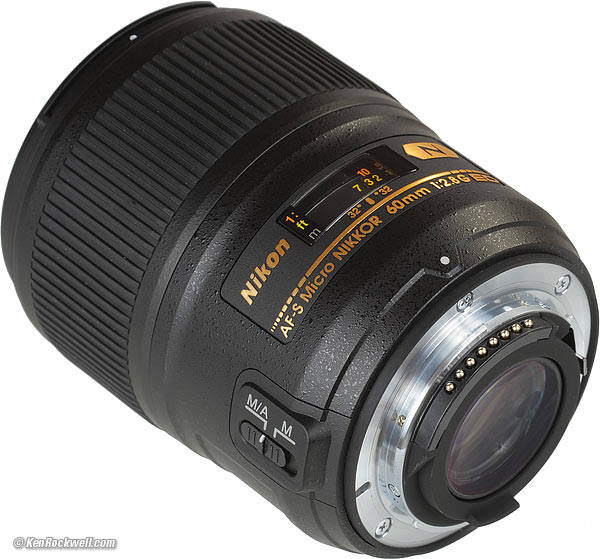
Nikon 60mm f/2.8 AF-S Micro-Nikkor.
History
1956-1961
Nikon made a 55mm f/3.5 Micro for rangefinder cameras. God only knows how you focused or composed.
1961-1979
Nikon made various versions of a 55mm f/3.5 manual-focus Micro. Nikon made about a half-million of these.
1979 - today
Nikon still makes the excellent manual focus 55mm f/2.8 AI-s Micro-Nikkor. Nikon has made about 600,000 of these — so far.
1986-1989
55mm f/2.8 AF, Nikon's first AF micro. Nikon only made about 50,000 of these.
1989-1993
60mm f/2.8 AF, the otherwise identical non-D version of the next lens. Nikon made about 150,000 of these non-D AF versions.
1993-2008
60mm f/2.8 AF-D, which is the same as the previous 60mm f/2.8 AF but adds the minor D feature. Nikon has made about 250,000 of the AF-D versions, or about 400,000 total of the first 60mm AF — so far.
2008 - today
This 60mm AF-S Micro is introduced to replace the 60mm AF-D Micro.
Specifications top
Intro Specifications Performance Recommendations
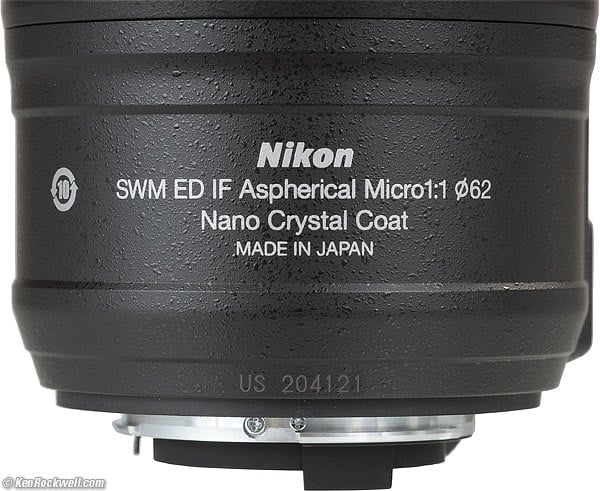
Underside, Nikon 60mm f/2.8 AF-S Micro-Nikkor.
Name
Nikon calls this the Nikon AF-S Micro NIKKOR 60mm f/2.8G ED. See the typo above? Nikon forgot a space between "Micro" and "1:1!"
Focal Length
60mm.
Used on a DX camera it gives angles of view similar to what a 90mm lens would give on an FX or 35mm film camera. See also Crop Factor.
Optics
12 elements in 9 groups. Highly advanced internal focus (IF) design with two aspherical and one ED element. Nikon Super Integrated Multicoating, with one element with nano crystal coat.
This is the world's first professional aspherical macro lens.
Diaphragm
9 rounded blades, stopping down to f/32. It's remarkable: it really stays round! At closer distances the lens becomes slower and it can stop down as far as f/57 at 1:1.
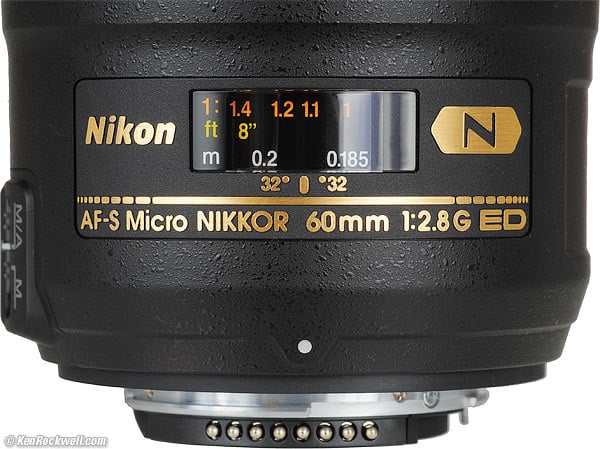
Focus and Identity Plate, Nikon 60mm f/2.8 AF-S Micro-Nikkor.
Close Focus
7.28" (0.185 m).
Maximum Reproduction Ratio
1:1.
Working Distance
I measure only 1-7/8" (48mm) at the closest focus distance (1:1). This is how close the front of the lens is to the subject at the closest focusing distance, and why I don't suggest 60mm micro lenses. A 105mm gives you enough room to work and not block your light. The earlier 60mm f/2.8 AF-D gives an extra inch.
Focus Distance Scale?
Yes.
Depth-of Field Scale?
Only for f/32.
Infra-Red Focus Index?
No.
Hard Infinity-Focus Stop?
No.
Filter Thread
62 mm, plastic, does not move.
Size
3.50" extension from flange x 2.874" diameter (89 x 73 mm), measured.
Nothing moves when focused.
Weight
15.100 oz. (428.0g), measured.
Nikon specifies 15.0 oz. (425 g).
Load Bearing Capacity
Up to four SB-R200 macro flashes may be attached to the front of the 60mm AFS.
Case
Foolish CL-1018 pouch, included.
Hood
HB-42 bayonet, included.
Nikon Product Number
2177.
Announced
28 January 2008
Available Since
March 2008
Price, USA
June 2013: About $550.
January 2011: About $540.
May 2008: About $550 US. Personally, I'd also be looking at the excellent older 60mm f/2.8 Macro for only about $390.
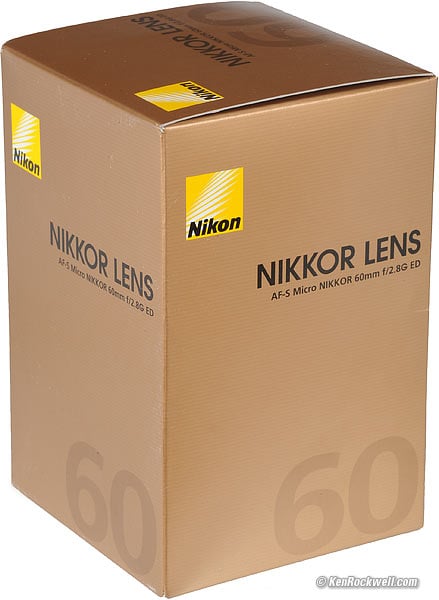
Box, Nikon 60mm f/2.8 AF-S Micro-Nikkor. (Wall thickness: 0.0275" (0.70mm).)
Performance top
Intro Specifications Performance Recommendations
Overall AF Bokeh Color Color Fringes Distortion Falloff Filters
Flash Maximum Aperture Mechanics Sharpness Working Distance
Overall back to Performance back to top
This 60mm f/2.8 AF-S is super sharp no matter what you do to it.
It has a lot of falloff (dark corners) at f/2.8; much worse than the 60mm f/2.8 AF-D.
The only things likely to tick anyone off are flaky AF performance on some cameras, and the simple truth that you have to get so close with a 60mm lens to shoot real macro that you get in the way of your own lighting.
Focus back to Performance back to top
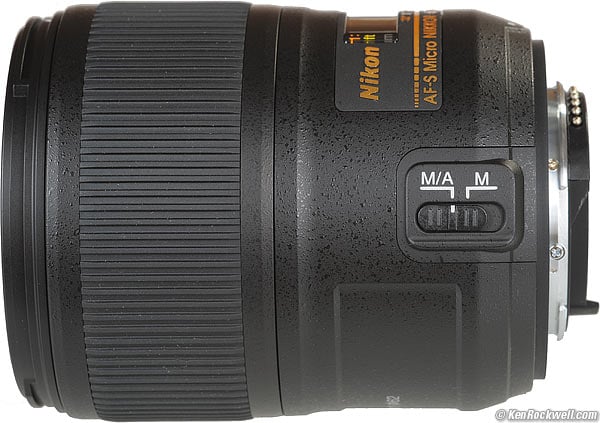
Focus Mode Switch, Nikon 60mm f/2.8 AF-S Micro-Nikkor.
General
Focus is entirely internal. Nothing except the focus ring moves on the outside.
The M/A - M switch is mislabeled. It should be marked A - M. In this case, the M/A position is gibberish which means you're in AF, but if you grab the focus ring, you get instant manual focus override.
Autofocus
AF is fast and reasonably solid on all compatible Nikon AF cameras, film and digital, except on Nikon's newest and smartest D3 and D300.
F4 fans: The F4 focuses faster than the D3 or D300 with this lens!
Problem: Autofocus on Nikon's newest D3 and D300, can get confused and not focus or act stupid if you're way out of focus when you start. It won't hunt; it will often not bother to start to look!
In other words, if focus is way off when you tap the shutter or AF button on the D3 and D300, often it won't even bother to try to focus. If any of the other cameras, including the D70, D200, F4, F6, or even the N75 can't find focus, they will run lock-to-lock trying to find focus anytime I tap the button.
AF is fine if you're reasonably in-focus when you hit the shutter button to start AF, but if you're way off, it's common that the D3 or D300 won't even bother to try to focus.
There is no focus range limiter to prevent this. If you have the lens set to 1:1 and focus on something at a distance, expect to be disappointed on the D3 and D300.
A work-around is to move the focus ring manually to roughly correct focus, and any camera will fine tune it from there with AF. This isn't acceptable: having to move the focus ring to get AF to work is one more step between you and your photo, and that lost time can lose you a decisive photo. Why buy a lens if it might lose a photo for you?
The older 60mm AF-D offers more consistent autofocus with the D300 and D3.
Manual Focus
Manual focus works great: just move the focus ring at any time. It feels great.
Bokeh back to Performance back to top
Bokeh is neutral to good. Blue circles are evenly illuminated discs.
The blur circles are always round. The superb 9-bladed diaphragm ensures that.
Color Rendition back to Performance back to top
Color seems neutral and matches my other AF Nikkors.
Distortion back to performance back to top
Sadly, this 60mm f/2.8 AF-S has some very slightly visible pincushion distortion on FX and film, presuming you're copying documents or otherwise looking for perfectly straight lines. Its RMS value over all tested distances is 0.376. It's not heinous, but lack of distortion is a reason people buy Micro lenses. Heck, the $110 50mm f/1.8 AF-D has less distortion, and it focuses as close as 14" (36cm) from the front of the lens.
The older 60mm f/2.8 AF-D (1993-2008), 60mm f/2.8 AF (1989-1993) and 55mm f/2.8 AI-s (1979-today) all have less distortion.
Luckily it's trivial to correct the 60mm AF-S' distortion by plugging these figures into Photoshop CS2's lens distortion filter. These aren't facts or specifications, they are the results of my research that requires hours of photography and calculations on the resulting data.
FX and Film |
||
infinity |
-0.4 |
0.0 |
30' (10m) |
-0.3 |
0.0 |
10' (3m) |
-0.5 |
|
3' (1m) |
-0.3 |
|
1' (0.3m) |
+0.1 |
|
1:1 life size |
-0.5 |
© 2008 KenRockwell.com. All rights reserved.
Falloff (darkened corners) back to performance back to top
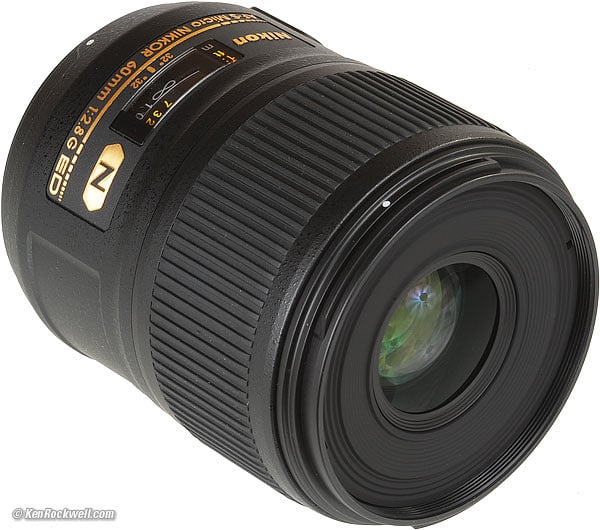
Nikon 60mm f/2.8 AF-S Micro-Nikkor.
See the tiny front element? It leads to strong falloff on film and FX digital at f/2.8 at infinity. It won't be a problem on DX cameras, if you stop down to f/4 or smaller, or shooting close-up.
I've exaggerated this by shooting a gray field and then placing these on the same gray background.
You will see falloff at f/2.8 on film and FX at infinity. If this is a concern for you, the older 60mm f/2.8 AF-D has much less falloff.
Falloff is negligible when used at 1:1 (very close-up).
Nikon 60mm f/2.8 AF-S falloff on film and FX at infinity.
At 1:10 on FX.
At 1:3 on FX.
At 1:1 on FX.
* at 1:1, maximum aperture is only f/4.8.
|
Filters, Use with back to Performance back to top
The tiny front element means you can use as many filters as you like with no fear of vignetting, on any FX or DX camera.
Nikon could have made this a 52mm filter thread instead of 62mm. Heck, the front element is only 27mm in diameter; a even 40.5mm filter thread would be generous enough to allow stacked filters.
If you want to use 52mm or even smaller filters, a step-down ring will work fine.
Flash, Use with back to Performance back to top
Since you have to get so close to your subject, if you attempt use the built-in flash at 1:1, the lens will cast a shadow and your subject won't be lit!
Forget it with a D40, D40x, D60, D70, D200 or D300. Their slightly smaller flashes don't reach high enough to clear the lens at 1:1. I haven't tried other cameras, but I suspect you're also out of luck. Forget the built-in flashes of film cameras; they cover an even greater angle of view.
You're fine with a shoe-mount flash.
It's silly to spend this much money on a specialized micro lens and not use the serious lighting it deserves, so don't worry about this. Use a ring-light or SB-R200, but forget on-camera flash.
Lateral Color Fringes back to Performance back to top
There are no color fringes on the D300 or D3, which would correct them if the 60mm f/2.8 AF-S had any.
There are also no color fringes on the D200, which means the 60mm f/2.8 AF-S simply has no color fringes.
Maximum Aperture back to performance back to top
The 60mm f/2.8 AF-S alters its optics as it focuses. It becomes slower as it's focused more closely.
Infinity |
f/2.8 |
10' (3m) |
f/2.8 |
3' (1m) |
f/3 |
1' (0.3m) |
f/3.2 |
8' (0.2m) |
f/4 |
1:1 life size |
f/4.8 |
© 2008 KenRockwell.com
Mechanics back to Performance back to top
This is precisely made lens with a plastic exterior.
Barrel Exterior
Plastic.
Filter Threads
Plastic.
Bayonet Hood Mount
Plastic.
Focus Ring
Metal and plastic, rubber covered.
Internals
Who knows, probably metal.
Mount
Dull-chromed brass.
Markings
Silver-gray paint.
Identity Plate
Embossed and planed metal.
Serial Number
Laser-engraved on bottom of plastic barrel near mount.
Ass-Gasket (dust seal at mount)
Yes.
Noises When Shaken
Slight klunking from all the glass which moves around inside for focusing.
Made in
Japan.
Sharpness back to Performance back to top
Sharpness, as expected, is crazy. It's sharp at every aperture everywhere in the frame on both an FX D3 as well as the DX D300. It doesn't get softer in the corners at f/2.8 at infinity as does the earlier 60mm f/2.8 AF-D, but the AF-D doesn't have as much falloff at f/2.8, so I prefer the older AF-D at f/2.8 anyway. No one buys macro lenses to shoot at f/2.8.
Diffraction is your only worry. Diffraction visibly dulls things starting at f/11 on a D300 and f/16 on a D3.
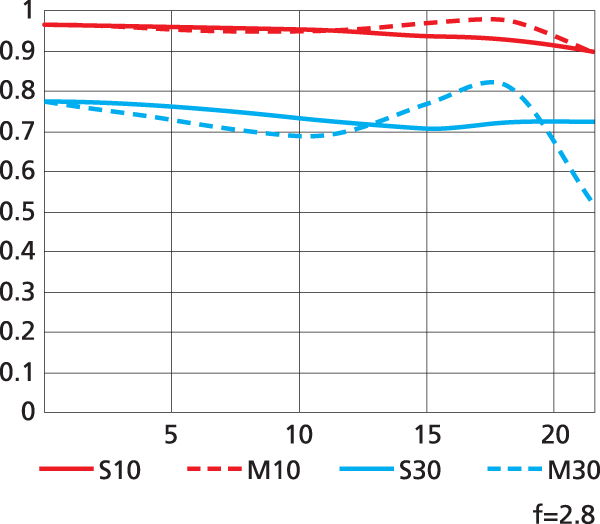
As expected, Nikon's MTF chart promises excellent sharpness. It's flat out to the edges, and my images confirm this. Nikon's MTF charts are for the lens wide-open; they improve stopped down, but Nikon doesn't show that.
Working Distance back to Performance back to top
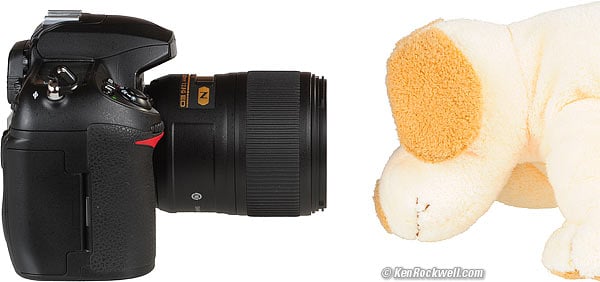
Nikon 60mm AF-S at closest focus distance. Good luck lighting your subject!
I measure only 1-7/8" (48mm) between the front of the lens and the subject at the closest focus distance (1:1).
This is why I don't suggest 60mm micro lenses: you will get in the way of your lighting, making this lens mostly useless at 1:1 except for copying slides.
A 105mm gives you enough room to work and not block your light.
The earlier 60mm f/2.8 AF-D gives and extra inch of working room.
Recommendations top
Intro Specifications Performance Recommendations
60mm macro lenses require you to get so close (2" or 5cm) to your subject at 1:1 that you get in the way of your own lighting! This is why pros don't use 60mm macro lenses, except for slide copying where the light comes from behind the subject.
If your intent is for serious macro, I'd strongly suggest a 105mm Micro-Nikkor instead to give enough room between your camera and the subject. My favorite is my old 105mm AF, not the the newer 105 VR. You should get a 105mm today if macro is your thing. If you try to go cheap with a 60mm, you'll be buying a 105mm in the future which winds up costing even more than starting with a 105mm. Bug and critter photographers use the 200mm micro lens to stand farther away from tiny subjects.
55mm and 60mm macro lenses are great for general photography, but not as small, handy and efficient as the less expensive and faster 50mm f/1.8 and 50mm f/1.4 lenses that cost way less. They are all as sharp.
If you still want a 60mm macro lens, I'd get the older older AF-D version while you still can because it has less distortion, offers an inch more working distance at 1:1 and autofocuses more consistently on the D3 and D300 than this new AF-S lens. The older AF-D costs $100-200 less than this AF-S.
The only advantage I see to this newest 60mm f/2.8 AF-S lens is that it autofocuses on Nikon's cheapest D40, D40x or D60 cameras. For real macro shooting, I usually shoot on manual focus anyway.
I'd keep a 62mm Nikon NC filter or a Hoya 62mm HMC UV Filter on it for protection.
More Information: Nikon, Japan.
Help me help you top
I support my growing family through this website, as crazy as it might seem.
The biggest help is when you use any of these links when you get anything, regardless of the country in which you live. It costs you nothing, and is this site's, and thus my family's, biggest source of support. These places have the best prices and service, which is why I've used them since before this website existed. I recommend them all personally.
If you find this page as helpful as a book you might have had to buy or a workshop you may have had to take, feel free to help me continue helping everyone.
If you've gotten your gear through one of my links or helped otherwise, you're family. It's great people like you who allow me to keep adding to this site full-time. Thanks!
If you haven't helped yet, please do, and consider helping me with a gift of $5.00.
As this page is copyrighted and formally registered, it is unlawful to make copies, especially in the form of printouts for personal use. If you wish to make a printout for personal use, you are granted one-time permission only if you PayPal me $5.00 per printout or part thereof. Thank you!
Thanks for reading!
Mr. & Mrs. Ken Rockwell, Ryan and Katie.
Home Donate New Search Gallery Reviews How-To Books Links Workshops About Contact

